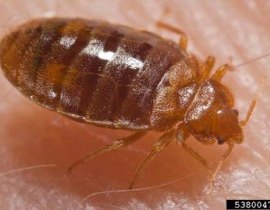Professional Pest Control & Wildlife Management
Bedbugs
‘Don’t let the bedbugs bite’ is a well known saying. Bedbugs Cimex lectularius are a parasitic insect which feeds on blood. Nocturnal they come out at night to feed upon human blood, often leaving three bite marks which is known as ‘breakfast, lunch and dinner’. Interestingly not everyone reacts to the bedbugs bite, it is possible to be sharing your home with these nasty little creatures and be completely unaware.
Most people do react to the bite, although you will not feel it in your sleep as they extract their blood feed from you. Bite marks will most likely occur on skin which is exposed during the night – arms and necks are favourites.
-
Risks
Bedbug bites do not necessarily carry a health risk although there is the chance of secondary infections (particulary if you scratch at them).
Despite the lack of a serious health risk bedbug bites will be itchy and unsightly, more than enough of a reason to want them removed. If left untreated bedbug infestations will continue to grow and spread throughout a building. As they seek nooks and crannies to hide away in during the daylight hours after feeding they are easily picked up in suitcases and so transferred from place to place.
-
Treatment
Bedbugs are notoriously difficult to eradicate. The egg casing is impenetrable to insecticides and the adults can ‘lie-up’ in difficult to treat locations.
For these reasons treatments must be thorough, all areas must be inspected and treated. All seams of the mattresses, all cracks and crevices, behind pictures, cupboards, wardrobes must be treated with the best insecticides available.
Light fittings and switches will require loosening to apply residual insecticide dust behind them.
We employ the latest formulations of pesticide in spray, dust and fumigation, and use a combination to provide an effective cure to these nasty parasites.
For a successful treatment we require good access to all areas of the rooms affected and adjoining rooms.
A second follow-up treatment is considered standard with additional visits possibly required.
Although we offer no guarentees we can say that we successfully removed each bedbug infestation we treated in 2012 in just one visit.
-
Life Cycle
From egg to adulthood Bedbug nymphs undergo five molts, each time increasing in size. The nymphs are identical to adults only smaller.
The eggs are sometimes found singularly or in small clusters and are glued onto the surface they are found upon. The eggs themselves are approximately 1/32 on an inch long and have a distinguishable ‘cap’ on one end. The female bedbug will lay upto 500 eggs throughout her life at a rate of 3 or 4 per day depending upon temperature and other influencing factors such as availability of food.
The eggs normally hatch after a period of between 6 and 14 days (again depending upon temperature) and can reach maturity in two months.
Adult bedbugs feed when hungry, normally every few days. Bedbugs can lie dormant without food for up to a year, fully grown they measure about 5mm.
Related
- False Widow Spider Removal
- Cluster Fly help
- The trouble with fleas?
- Mole Catching in Suffolk
- Rats in the Garden
- Wasp Nest Control
- Rats in your chicken Coop
- Anaphylaxis
- Bee Swarms
- Becoming a Beekeeper
- Rare Breed Poultry
- Pest Control with Birds of Prey
- Un-marked vehicles available
- Rabbiting with Ferrets
- Myxomatosis
- Poll-Tex Mesh
- Honorary Member Russell Wallis
- Free Rabbit Control


